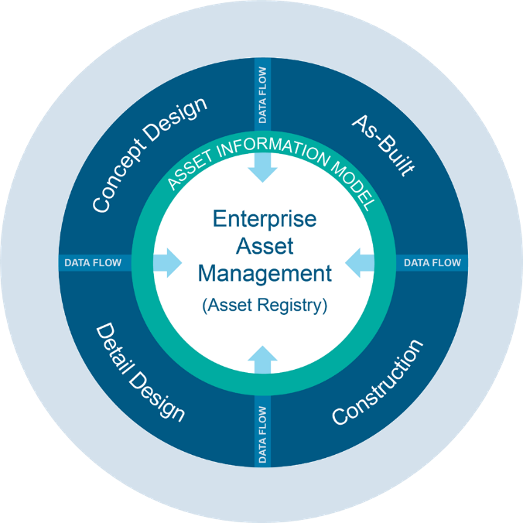
Asset Life Cycle and BIM
Building Information Modeling (BIM) for Transportation has emerged as a process that supports asset life-cycle data integration. As technology has evolved to be more and more interoperable, industry is seeing the advantages of leveraging BIM and a common data environment to support the asset life cycle from end to end.
Asset information developed during project planning and design can seamlessly flow through to the construction and operations phases, generating efficiencies in each project phase and yielding a detailed asset information model to inform asset operation and maintenance.
Project Planning
During project planning key decisions are made regarding site location, constructability, and regulatory requirements. Assets within the project limits may inform planning decisions. For example, Federal project requirements may dictate that safety assets (e.g. guardrail) are evaluated and brought to current standards during the project. By integrating existing asset information into project planning systems, these activities can be streamlined and planning outcomes are improved.
Geospatial information systems (GIS) databases and tools are customarily used during planning. GIS data collected and generated during planning regarding boundary constraints, material considerations, or site conditions are key inputs to the Project Delivery. Ensure that data workflows from Planning to Development consider how these data are passed on to create efficiencies in future phases.
Project Development
Project development includes the financing and design aspects of an infrastructure project. Schematic and detailed designs progress the project plan into a constructible state. Designs typically include asset location, size, material, type or standard, and other asset information. These can be coded in the model to meet the owner’s specification and then leveraged during project delivery.
Project Delivery
Project delivery represents the physical construction of the new asset. During this phase information contained in the design model can be carried forward to inform and optimize the construction phase. As-built information can also be captured during project delivery.
Handover/Handoff
At the completion of construction, the asset is handed over for management and maintenance. At this stage, asset life-cycle data integration workflows yield the most significant benefit. Data developed and evolved through the project phases can be transferred directly into the owner’s asset data model and be subsequently maintained through the owner/operator asset management systems, providing updated asset inventory, condition, and work history.
The following terms are used within this Section.
The asset life cycle is broken down into phases representing key milestones in the development of the asset – starting with planning, then development, then delivery, and ultimately operation and maintenance.
Mature data integration workflows are often supported by batch processing. Batch processing allows for certain data transformation tasks to be performed according to a routine, frequently without human intervention.
The process of converting data from one format to another, often required to support data integration workflows, particularly when different technologies are employed by different users or stakeholders over the asset life-cycle.
Based on performance measurements intended to provide evidence or give indication of an assets level of service or performance, performance targets can be directly imposed by regulators or set based on strategic objectives of an organization. Targets can be established to meet a minimum level of service committed to the users of that asset (e.g. smoothness of pavement) or aspirational if an organization is trying to enhance the level of service to encourage use or thwart competition (e.g. lower congestion levels on managed lanes).
Most planning activity occurs in the 2D space using tools like GIS. These include site selection, alignment alternatives, and environmental constraints analysis. Interoperability between GIS and design tools is affording new efficiencies that eliminate needs for exporting/importing data to inform design (e.g. Esri’s Autodesk Connector for ArcGIS). Through these tools, planning data can be shared directly with designers to inform decision-making. For example, soil information can influence material selections or placement of pilings.
Project Development to Project DeliveryCurrent DOT practices typically involve disconnected processes where the design model is discarded and the contractor defines a model optimized for their delivery purpose. These inefficiencies ultimately translate to additional costs for the owner. Alternative delivery methods are creating new efficiencies, but infrastructure owners can take responsibility for defining model requirements throughout the phases of design-bid-build projects.
Project Delivery to Asset Inventory/Condition & Work OrdersWhen model specifications are defined contractually, the as-built plans can be delivered digitally as as-built models. With model specifications directly aligned with the asset information model, the assets defined in the as-built model can be imported to supplement the asset inventory. Valuable as-built condition information – such as location, photos, manufacturer recommended maintenance schedules, warranties, etc. – can be retained for use in maintenance works ordering, warrantee claims, and general asset management and operation.
